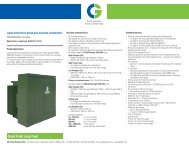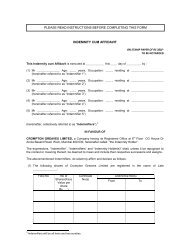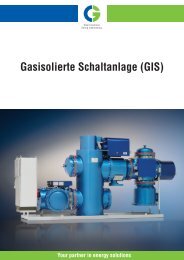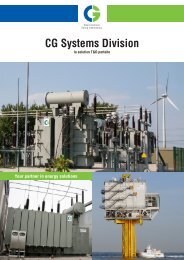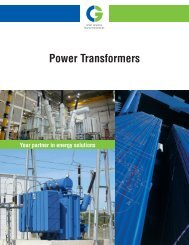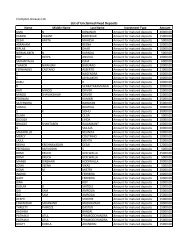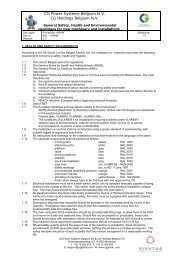Create successful ePaper yourself
Turn your PDF publications into a flip-book with our unique Google optimized e-Paper software.
Crompton Greaves Ltd.<br />
Significant Accounting Policies<br />
SCHEDULE [ A ]<br />
1 BASIS OF PRESENTATION<br />
The accounts have been prepared using historical cost convention, except for the revaluation of certain<br />
fixed assets, in accordance with the Generally Accepted Accounting Principles (GAAP) on the accrual basis<br />
and in accordance with the Accounting Standards referred to in Section 211(3C) and other provisions of<br />
the Companies Act 1956. Insurance and other claims are accounted for as and when admitted by the<br />
appropriate authorities.<br />
The preparation of accounts under GAAP requires management to make estimates and assumptions that<br />
affect the reported amounts of assets & liabilities and disclosures of contingent liabilities as at the date of<br />
the financial statements and the reported amounts of revenues and expenses during the year. Actual<br />
results could differ from those estimates. Any revisions to accounting estimates is recognised prospectively<br />
in the current and future periods.<br />
2 FIXED ASSETS<br />
(a)<br />
(b)<br />
(c)<br />
(d)<br />
(e)<br />
(f)<br />
Fixed assets are stated at cost, except for land and buildings added prior to 30th June 1985 which<br />
are stated at revalued cost as at that date based on technical expert’s evaluation report.<br />
Expenditure relating to existing fixed assets is added to the cost of the assets where it increases the<br />
performance / life of the assets as assessed earlier.<br />
Fixed assets are eliminated from financial statements, either on disposal or when retired from active<br />
use. Such assets are removed from fixed asset records on disposal. Generally, such retired assets<br />
are disposed off soon thereafter.<br />
Pre-operative expenses for the projects incurred till the projects are ready for <strong>com</strong>mercial production<br />
are capitalised.<br />
Internally manufactured / constructed fixed assets are capitalised at factory cost including excise<br />
duty wherever applicable.<br />
Lumpsum fees paid for acquisition of technical knowhow relating to Plant & Machinery is capitalised<br />
as intangible asset.<br />
(g) i) Machinery spares which are specific to particular item of Fixed Assets and whose use is irregular<br />
are capitalised as part of the cost of machinery.<br />
ii)<br />
Machinery spares which are not specific to a particular item of Fixed Assets but can be used<br />
generally for various items of Fixed Assets are treated as inventory and charged to Profit and<br />
Loss Account as and when issued for consumption in the ordinary course of operation.<br />
3 INVESTMENTS<br />
Current Investments are carried at lower of cost or market value. The determination of carrying costs of<br />
such investments is done on the basis of specific identification. Long term investments are carried at cost<br />
after providing for any diminution in value, if such diminution is of a permanent nature.<br />
4 INVENTORIES<br />
Inventories are valued at the lower of cost or net realisable value after providing for obsolescence and<br />
damage as under:-<br />
(a) Raw materials, packing materials : At Cost, on FIFO/Weighted average basis<br />
stores & spares and construction<br />
material<br />
(b) Work-in-Process : At Cost plus appropriate production overheads<br />
(c) Construction Work-in-Progress : At Cost till a certain percentage of <strong>com</strong>pletion and thereafter<br />
realisable value<br />
(d) Finished goods : At Cost, plus appropriate production overheads, including<br />
excise duty paid/payable on such goods.<br />
71





